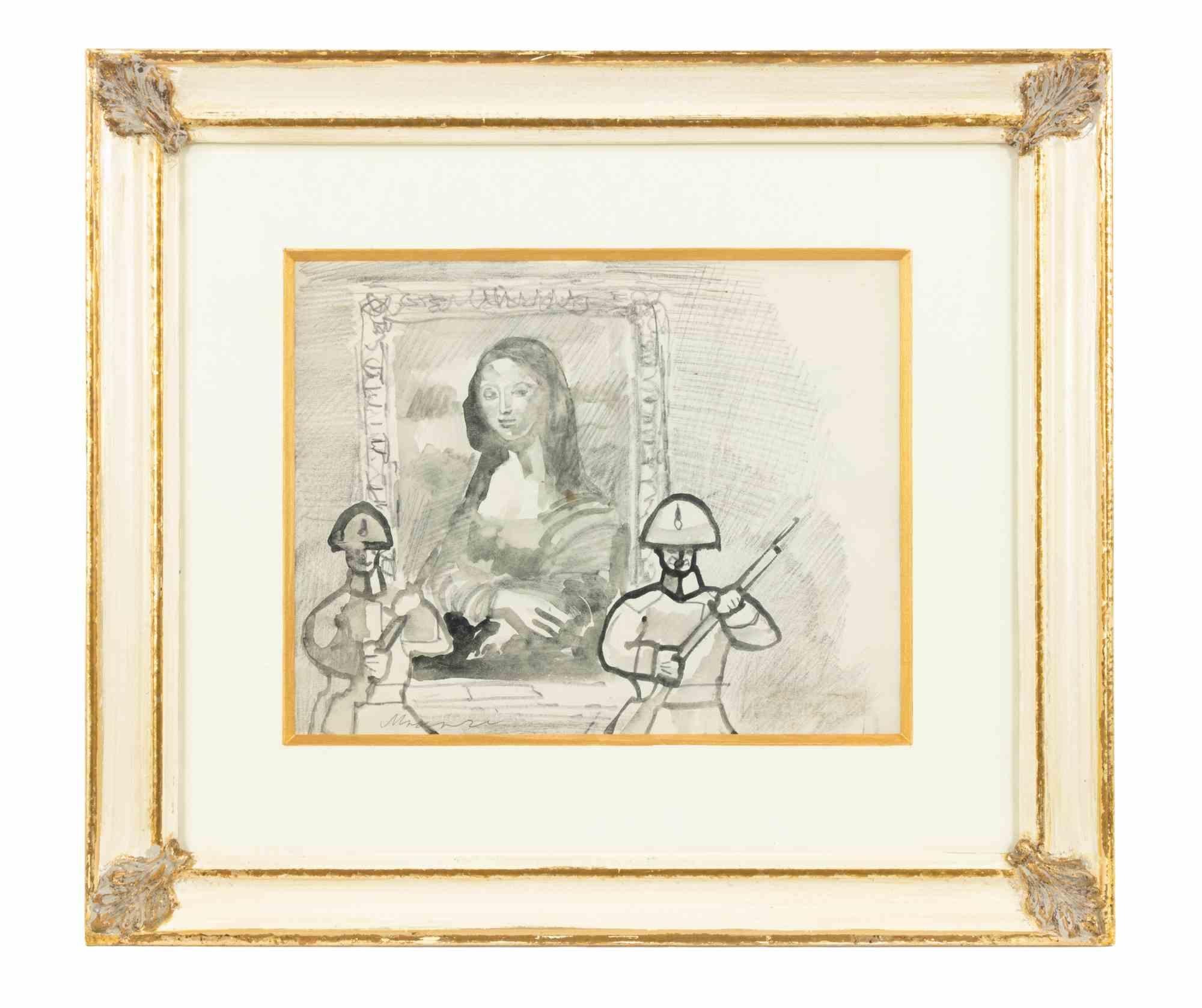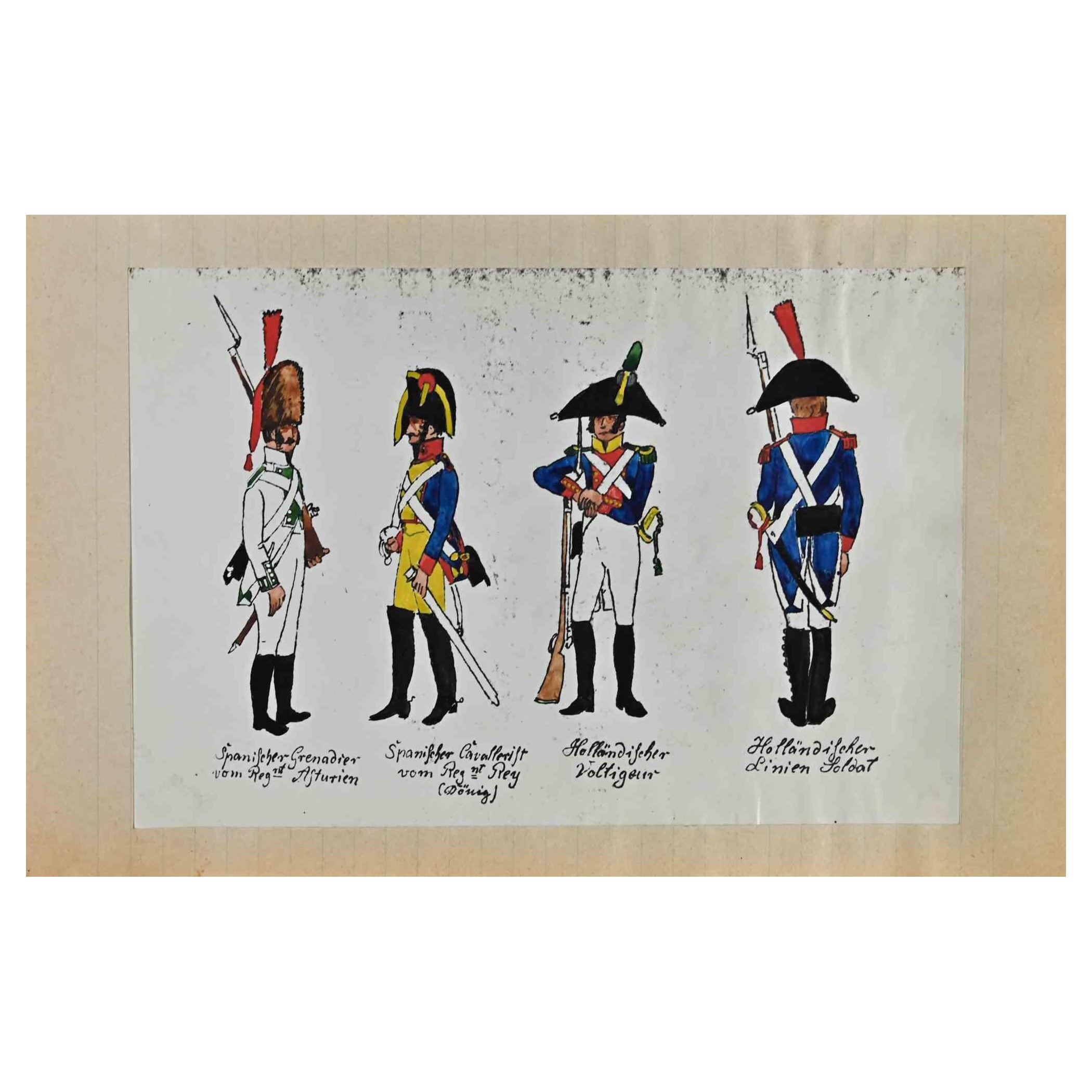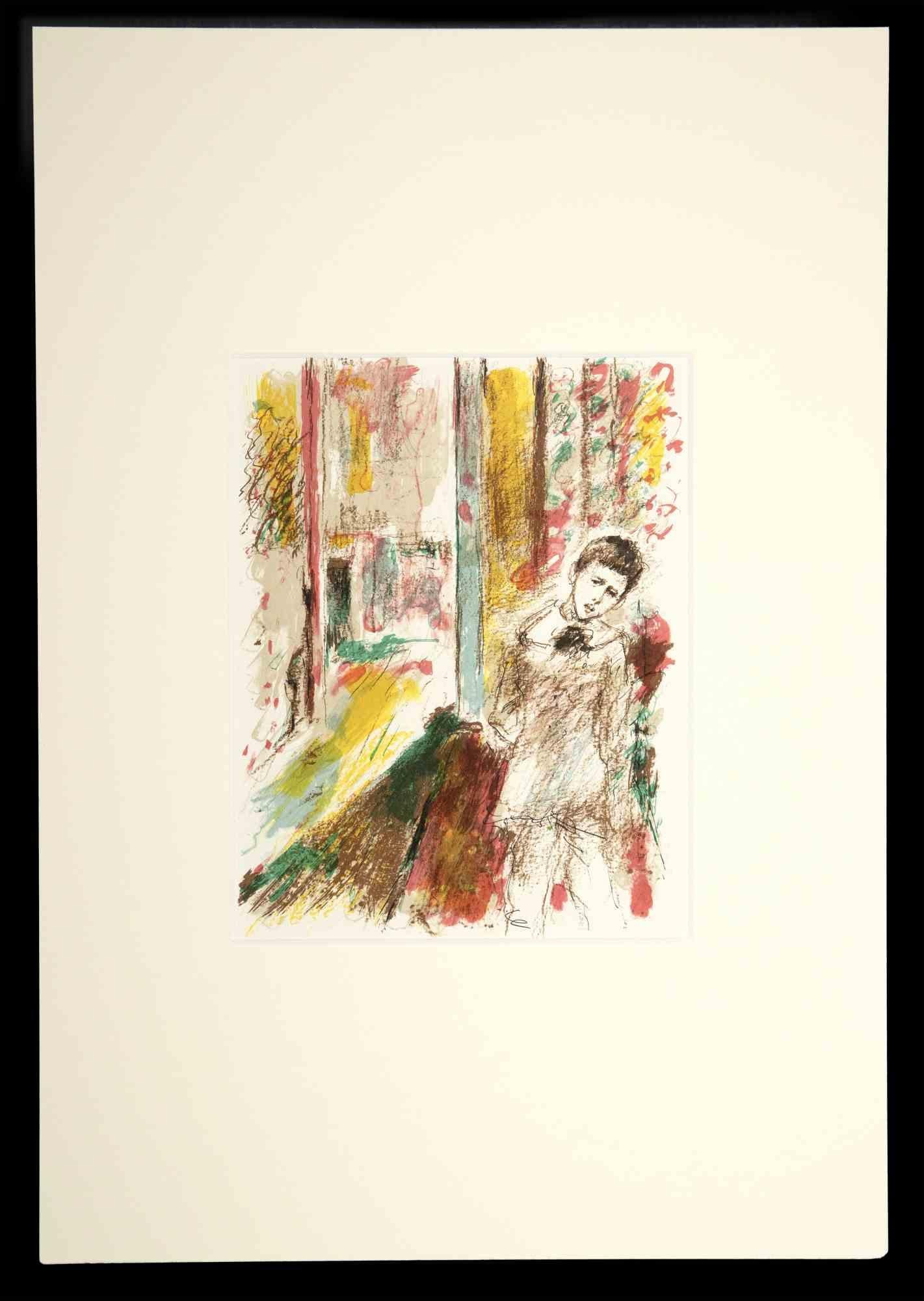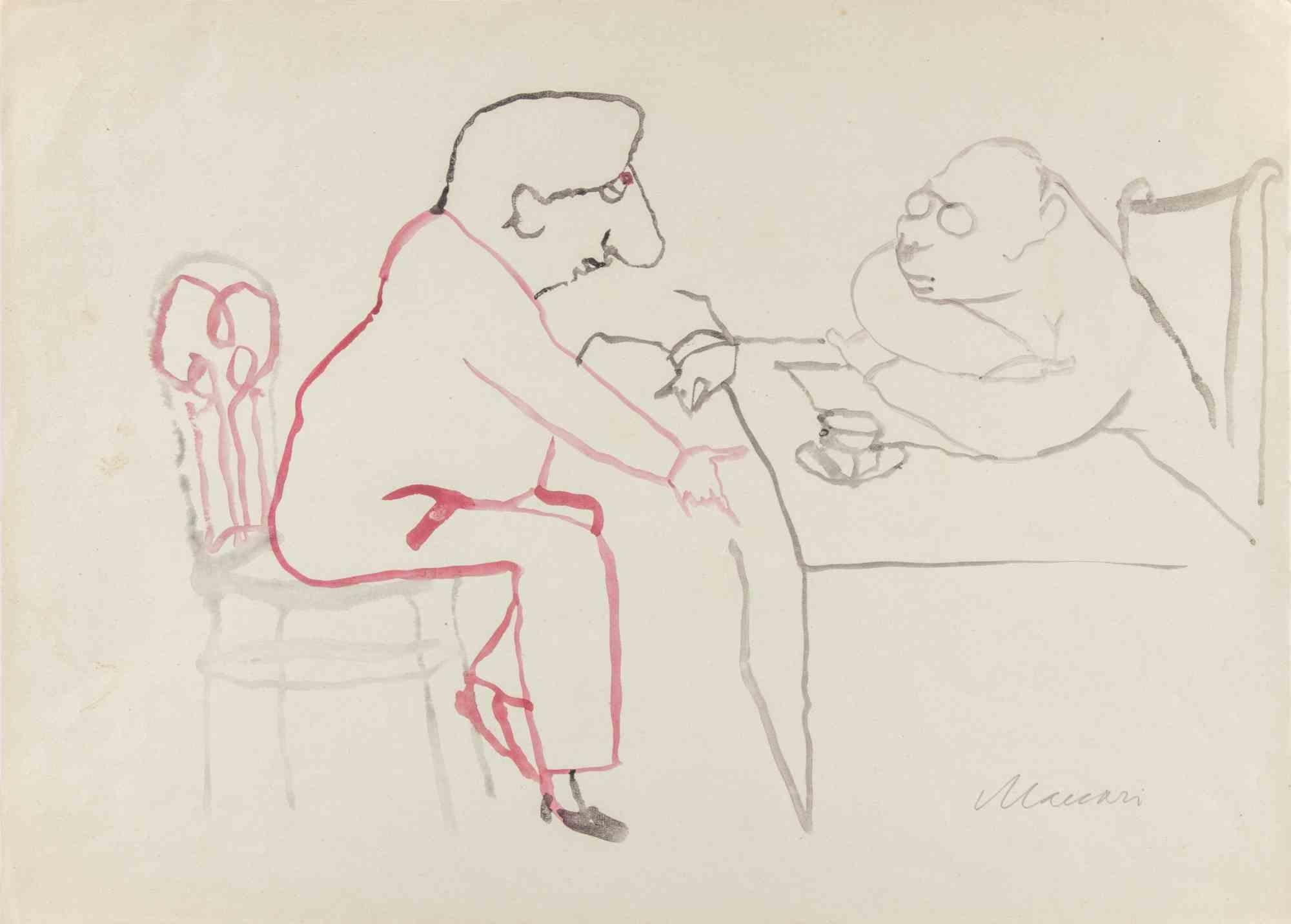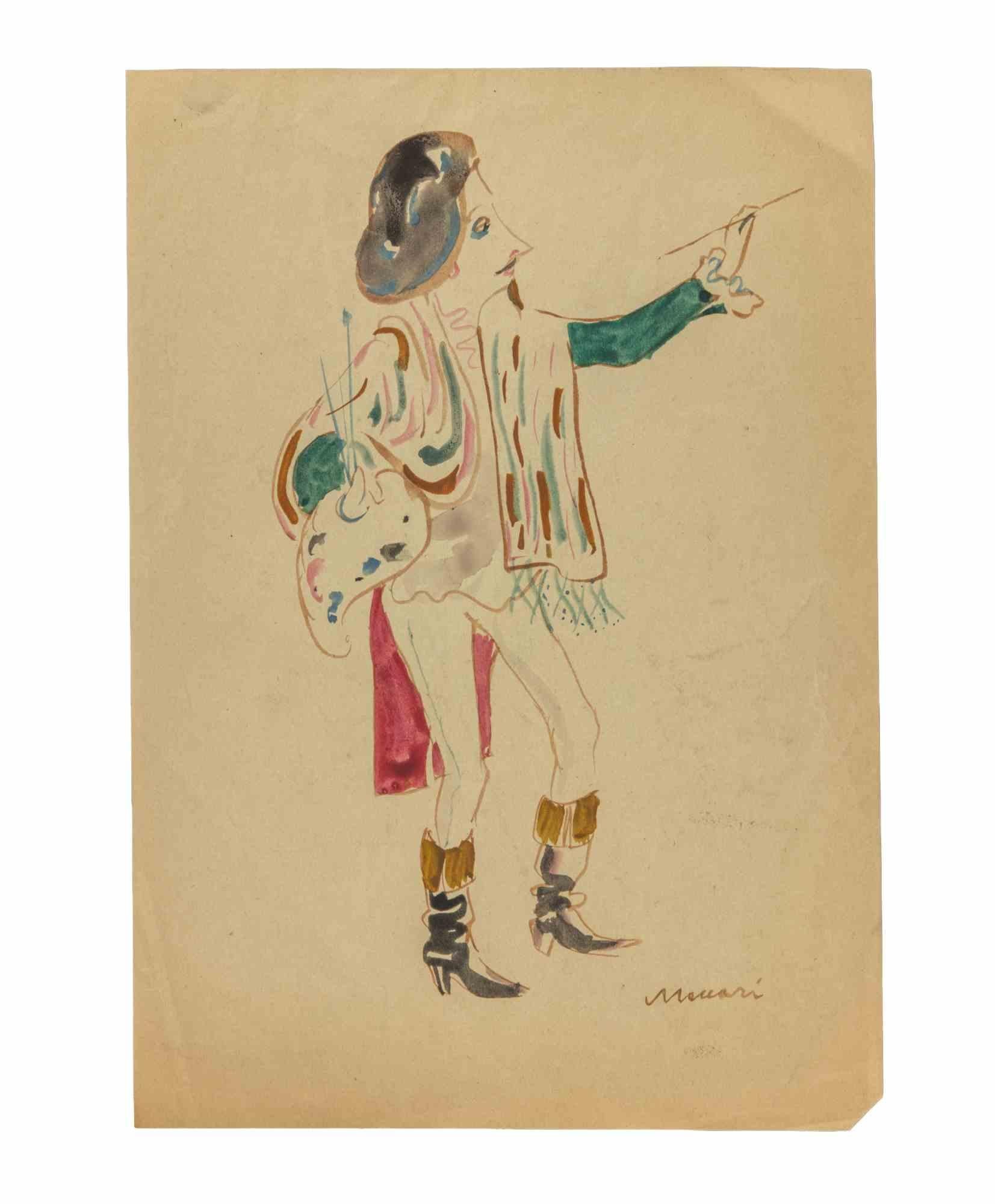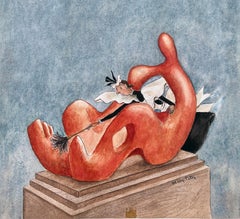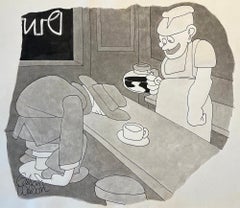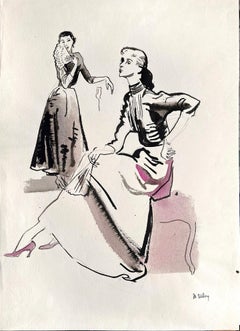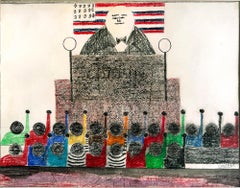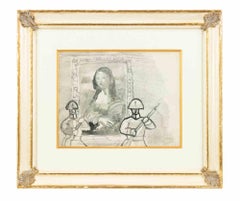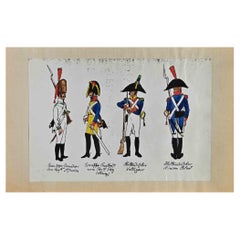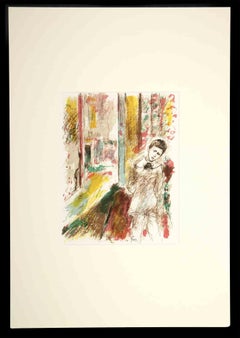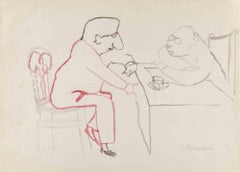Items Similar to Interracial Love - New York City Street Scene - Proposition - Red Light District
Want more images or videos?
Request additional images or videos from the seller
1 of 8
Philip ReismanInterracial Love - New York City Street Scene - Proposition - Red Light District1970 circa
1970 circa
About the Item
In the 1970s, the Times Square/ Mid-Town area of New York City was a gritty place of X-rated movies, Strip Bars, Pimps, Street Walkers, and cheap by-the-hour Hotels. The place was as edgy as it was magnetic. "Proposition" is a slice of life at that moment in history. Philip Reisman was an observer of New York's street life, and this work seems to depict a working girl with platform shoes and a John engaging in a romantic embrace.
Signed lower right with gallery label on verso. Framed under glass.
Reisman is a people painter. He studied at the Art Students League with George B. Bridgeman. By working at odd jobs he was able to take classes there for six years. His early paintings were candid, crowded scenes of the life he saw around him on the Lower East Side of New York: butchers, carters, peddlers, and homeless men in the Bowery. His first one-man show in 1932 was a critical success. His work is in the Smithsonian Museum, Museum of Modern Art, New York City Museum, Whitney Museum of American Art, among others.
- Creator:Philip Reisman (1904-1992, American)
- Creation Year:1970 circa
- Dimensions:Height: 19.75 in (50.17 cm)Width: 9.25 in (23.5 cm)Depth: 2 in (5.08 cm)
- Medium:
- Movement & Style:
- Period:
- Condition:some slight fading of color and toning of the paper. Frame and matting shows wear.
- Gallery Location:Miami, FL
- Reference Number:1stDibs: LU385313050112

About the Seller
4.9
Vetted Professional Seller
Every seller passes strict standards for authenticity and reliability
Established in 2005
1stDibs seller since 2016
112 sales on 1stDibs
Typical response time: <1 hour
- ShippingRetrieving quote...Shipping from: Miami, FL
- Return Policy
Authenticity Guarantee
In the unlikely event there’s an issue with an item’s authenticity, contact us within 1 year for a full refund. DetailsMoney-Back Guarantee
If your item is not as described, is damaged in transit, or does not arrive, contact us within 7 days for a full refund. Details24-Hour Cancellation
You have a 24-hour grace period in which to reconsider your purchase, with no questions asked.Vetted Professional Sellers
Our world-class sellers must adhere to strict standards for service and quality, maintaining the integrity of our listings.Price-Match Guarantee
If you find that a seller listed the same item for a lower price elsewhere, we’ll match it.Trusted Global Delivery
Our best-in-class carrier network provides specialized shipping options worldwide, including custom delivery.More From This Seller
View AllClass Struggle - Fay the Maid Dusts Henry Moore - New Yorker Magazine?
Located in Miami, FL
Mary Petty gained fame as a cover artist for The New Yorker, illustrating a fictional upper-class Manhattan family called the Peabodys. One of the main char...
Category
1940s Modern Figurative Drawings and Watercolors
Materials
Watercolor, Ink
How About a Little More Coffee, New Yorker Cartoon
Located in Miami, FL
Interpretation 1: An utterly exhausted man collapses face-first into a diner's countertop. His face and the countertop become one. Seemingly oblivious to the acute nature of the man's condition, the night server gleefully offers him coffee instead of more appropriate help. Interpretation 2: The night server/psycho killer pours unsuspecting customer poisoned coffee and then taunts his lifeless body in a victorious tone. Like Charles Addams...
Category
1990s Modern Figurative Drawings and Watercolors
Materials
Ink, Watercolor
Mid- Century Fashion Illustration - Neiman Marcus ?
By Marjorie Ullberg
Located in Miami, FL
1950's elegant fashion models pose depicted for a designer clothing line for a major San Francisco department store - Perhaps Neiman Marcus. Estate ...
Category
1950s Modern Figurative Drawings and Watercolors
Materials
Watercolor, Pencil
Black Panther Trials - Civil Rights Movement Police Violence African American
Located in Miami, FL
The Black Panther Trials - In this historically significant work, African American Artist Vicent D. Smith functions as an Art Journalist/ Court Reporter as much as a
Artist. Here, he depicts, in complete unity, 21 Black Panther Protestors raising their fist of defiance at the White Judge. Smith's composition is about utter simplicity, where the Black Panther Protestors are symmetrically lined up in a confrontation with a Judge whose size is exaggerated in scale. Set against a stylized American Flag, the supercilious Judge gazes down as the protesters as their fists thrust up. Signed Vincent lower right. Titled Panter 21. Original metal frame. Tape on upper left edge of frame. 255 . Panther 21. Framed under plexi.
_____________________________
From Wikipedia
In 1969-1971 there was a series of criminal prosecutions in New Haven, Connecticut, against various members and associates of the Black Panther Party.[1] The charges ranged from criminal conspiracy to first-degree murder. All charges stemmed from the murder of 19-year-old Alex Rackley in the early hours of May 21, 1969. The trials became a rallying-point for the American Left, and marked a decline in public support, even among the black community, for the Black Panther Party
On May 17, 1969, members of the Black Panther Party kidnapped fellow Panther Alex Rackley, who had fallen under suspicion of informing for the FBI. He was held captive at the New Haven Panther headquarters on Orchard Street, where he was tortured and interrogated until he confessed. His interrogation was tape recorded by the Panthers.[2] During that time, national party chairman Bobby Seale visited New Haven and spoke on the campus of Yale University for the Yale Black Ensemble Theater Company.[3] The prosecution alleged, but Seale denied, that after his speech, Seale briefly stopped by the headquarters where Rackley was being held captive and ordered that Rackley be executed. Early in the morning of May 21, three Panthers – Warren Kimbro, Lonnie McLucas, and George Sams, one of the Panthers who had come East from California to investigate the police infiltration of the New York Panther chapter, drove Rackley to the nearby town of Middlefield, Connecticut. Kimbro shot Rackley once in the head and McLucas shot him once in the chest. They dumped his corpse in a swamp, where it was discovered the next day. New Haven police immediately arrested eight New Haven area Black Panthers. Sams and two other Panthers from California were captured later.
Sams and Kimbro confessed to the murder, and agreed to testify against McLucas in exchange for a reduction in sentence. Sams also implicated Seale in the killing, telling his interrogators that while visiting the Panther headquarters on the night of his speech, Seale had directly ordered him to murder Rackley. In all, nine defendants were indicted on charges related to the case. In the heated political rhetoric of the day, these defendants were referred to as the "New Haven Nine", a deliberate allusion to other cause-celebre defendants like the "Chicago Seven".
The first trial was that of Lonnie McLucas, the only person who physically took part in the killing who refused to plead guilty. In fact, McLucas had confessed to shooting Rackley, but nonetheless chose to go to trial.
Jury selection began in May 1970. The case and trial were already a national cause célèbre among critics of the Nixon administration, and especially among those hostile to the actions of the FBI. Under the Bureau's then-secret "Counter-Intelligence Program" (COINTELPRO), FBI director J. Edgar Hoover had ordered his agents to disrupt, discredit, or otherwise neutralize radical groups like the Panthers. Hostility between groups organizing political dissent and the Bureau was, by the time of the trials, at a fever pitch. Hostility from the left was also directed at the two Panthers cooperating with the prosecutors. Sams in particular was accused of being an informant, and lying to implicate Seale for personal benefit.
In the days leading up to a rally on May Day 1970, thousands of supporters of the Panthers arrived in New Haven individually and in organized groups. They were housed and fed by community organizations and by sympathetic Yale students in their dormitory rooms. The Yale college dining halls provided basic meals for everyone. Protesters met daily en masse on the New Haven Green across the street from the Courthouse (and one hundred yards from Yale's main gate). On May Day there was a rally on the Green, featuring speakers including Jean Genet, Abbie Hoffman, Jerry Rubin, and John Froines (an assistant professor of chemistry at the University of Oregon). Teach-ins and other events were also held in the colleges themselves.
Towards midnight on May 1, two bombs exploded in Yale's Ingalls Rink, where a concert was being held in conjunction with the protests.[4] Although the rink was damaged, no one was injured, and no culprit was identified.[4]
Yale chaplain William Sloane Coffin stated, "All of us conspired to bring on this tragedy by law enforcement agencies by their illegal acts against the Panthers, and the rest of us by our immoral silence in front of these acts," while Yale President Kingman Brewster Jr. issued the statement, "I personally want to say that I'm appalled and ashamed that things should have come to such a pass that I am skeptical of the ability of a Black revolutionary to receive a fair trial anywhere in the U.S." Brewster's generally sympathetic tone enraged many of the university's older, more conservative alumni, heightening tensions within the school community.
As tensions mounted, Yale officials sought to avoid deeper unrest and to deflect the real possibility of riots or violent student demonstrations. Sam Chauncey has been credited with winning tactical management on behalf of the administration to quell anxiety among law enforcement and New Haven's citizens, while Kurt Schmoke, a future Rhodes Scholar, mayor of Baltimore, MD and Dean of Howard University School of Law, has received kudos as undergraduate spokesman to the faculty during some of the protest's tensest moments. Ralph Dawson, a classmate of Schmoke's, figured prominently as moderator of the Black Student Alliance at Yale (BSAY).
In the end, compromises between the administration and the students - and, primarily, urgent calls for nonviolence from Bobby Seale and the Black Panthers themselves - quashed the possibility of violence. While Yale (and many other colleges) went "on strike" from May Day until the end of the term, like most schools it was not actually "shut down". Classes were made "voluntarily optional" for the time and students were graded "Pass/Fail" for the work done up to then.
Trial of McLucas
Black Panther trial sketch...
Category
1970s American Modern Figurative Drawings and Watercolors
Materials
Watercolor, Pen, Pencil, Paper
Five Fashion Models Wearing Hoodies Vogue Patterns 1970s Fashion - Puerto Rican
By Antonio Lopez
Located in Miami, FL
Famed Puerto Rican Fashion Illustrator Antonio Lopez creates an oversized illustration for Vogue Patterns Magazine 1971. He uses a variety of media whic...
Category
1970s Modern Figurative Drawings and Watercolors
Materials
Paper, Mixed Media, Watercolor
Black Power, Attica Prison Riot Prisoners Racial Justice - African American Art
Located in Miami, FL
African American Artist Vincent D Smith makes a statement about racial justice. In this work from 1972, he depicts three African American prisoners with their faces pushed up agains...
Category
1970s Modern Figurative Drawings and Watercolors
Materials
Watercolor
You May Also Like
Monna Lisa - Drawing by Mino Maccari - Mid-20th Century
By Mino Maccari
Located in Roma, IT
Monna Lisa is an original modern artwork realized by Mino Maccari in the mid-20th Century.
Watercolor drawing.
Hand signed on the lower margin.
Includes frame: 49 x 3 x 43
Category
Mid-20th Century Modern Figurative Drawings and Watercolors
Materials
Paper, Watercolor
Spanish and Dutch Soldiers - Original drawing By Herbert Knotel - 1940s
Located in Roma, IT
Spanish and Dutch Soldiers is an original drawing in ink and watercolor realized by Herbert Knotel in 1930/40s.
Good condition except for being aged.
The artwork is depicted through strong lines in well-balanced conditions.
Herbert Knotel was a german artist, son and pupil of the famous uniformologist and military historian Richard Knotel...
Category
1940s Modern Figurative Drawings and Watercolors
Materials
Ink, Watercolor
The Young Student - Original Drawing - Early 20th Century
Located in Roma, IT
The Young Student is an original drawing in Ink, Watercolor, and pastel by an anonymous artist in the first half of the 20th Century.
Good conditions.
The artwork is depicted throu...
Category
Early 20th Century Modern Figurative Drawings and Watercolors
Materials
Pastel, Ink, Watercolor
The Painter Giorgio De Chirico - Drawing by Mino Maccari - 1950 ca
By Mino Maccari
Located in Roma, IT
Watercolor on paper realized by Mino Maccarin in the 1950s. It depicts the painter and Master of Pittura Metafisica Giorgio De Chirico.
Hand signed.
Very good condition.
Category
1950s Modern Figurative Drawings and Watercolors
Materials
Watercolor
Portrait of Minister Scelba - Drawing by Mino Maccari - 1954
By Mino Maccari
Located in Roma, IT
China Ink and watercolor on cardboard realized by Mino Maccari in 1954, and depicting the former italian Prime Minister Mario Scelba.
Hand signed.
Very good condition
Category
1950s Modern Figurative Drawings and Watercolors
Materials
Watercolor, Ink
The Painter - Drawing by Mino Maccari - 1945 ca.
By Mino Maccari
Located in Roma, IT
Ink and Watercolor drawing realized by Mino Maccari in 1945 ca.
Hand signed lower right.
Very good condition.
Category
1940s Modern Figurative Drawings and Watercolors
Materials
Ink, Watercolor
Recently Viewed
View AllMore Ways To Browse
New York Street Sign
Love Scene
New York City Street Scenes
District Modern
Georges B
Street Scene Watercolor
Modern American Street Scene
Magnetic Light
Shoe Drawing
New York City Times Square
Men Embraced
Vintage American Shoes
Carter Love
John Carter Galleries
Mens Shoe Painting
Carter For Men
Vintage Peddler
Vintage 1970s Mens Shoes
